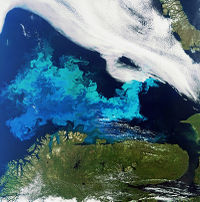Portal:Eutrophication
From Coastal Wiki
edit
Eutrophication
Eutrophication ('eu' = true or well; 'trophy' = food) is a leading threat to water quality around the world. In the North Sea and English Channel, the phenomenon is related to two major activities: agriculture and industry. This gives an excess of nutrients (nitrates, phosphates,...) in the water. This enrichment promotes the growth of algae. A small increase in algal biomass does not have any adverse effect on the ecosystem and can even result in an increase in certain fish populations. An over-stimulation of the growth of algae (an algal bloom), however, can lead to turbidity of the water. When the algae die, the water may be temporarily low in oxygen (hypoxia) what can result in the death of many fish.
edit
Concept drawing
edit
Learn more about eutrophication
What are Portals? | List of portals

